Zotac's Ion: The World's First mini-ITX Ion Board
by Anand Lal Shimpi on May 12, 2009 12:00 AM EST- Posted in
- GPUs
The Zotac Ion is available as a mini-ITX motherboard alone. Mini-ITX will work in ATX, micro-ATX, and mini-ITX cases.
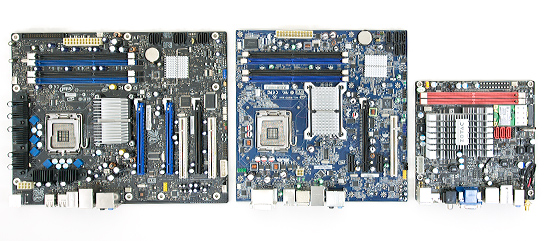
From left to right (ATX, micro-ATX and mini-ITX)
There are two versions of Zotac’s Ion, the ION-ITX-A-U and the ION-ITX-B-E. The more expensive “A” model ships with a dual-core Atom 330 processor, a mini-PCIe WiFi card and an external DC power supply. The “B” model comes with a single-core Atom 230 processor, no WiFi and requires a standard power supply. They are priced at $189 and $139, respectively, from etailers. Add another $10 for retail pricing. Update: Zotac just informed me of two additional versions coming: a C and a D version. The C version will be a single-core product with the DC power supply and the D version will be a dual-core product with no power supply.
Availability will be in limited quantities starting this week. Zotac hopes to have more widespread availability by June.
The first change compared to Intel’s desktop Atom boards is that the Zotac board is entirely passively cooled. While Zotac ships a fan in the box, it’s optional to use. Granted the heatsink on the Zotac Ion is huge, inevitably adding more cost to the board but I’d take that over a spinning fan; the Zotac Ion is completely silent.
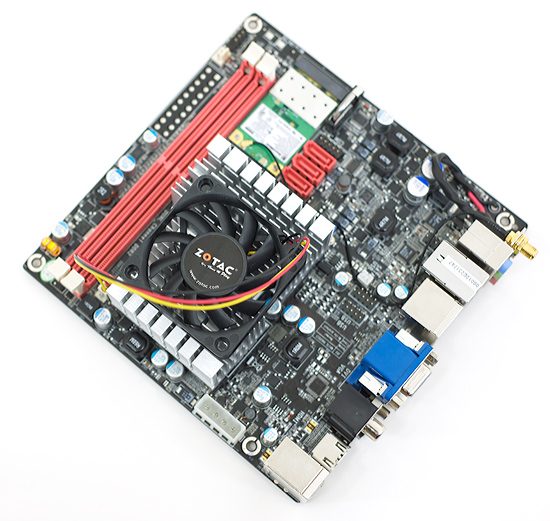
The optional fan
Zotac gives us two DDR2 DIMM slots (4GB max total memory) instead of one on the Intel boards, and it supports up to DDR2-800 memory. While Zotac could’ve opted for DDR3 slots, DDR2 seems like a safer bet since you’re more likely to have spare DDR2 memory laying around these days (especially after you make that upgrade to Phenom II or Core i7).
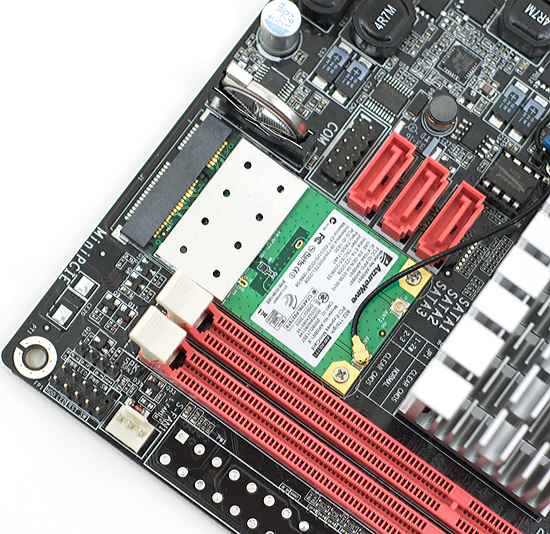
Oooo, expansion
We get three SATA ports instead of two, but no PATA ports. There’s no PCI slot but you do get a mini-PCIe slot for an optional WiFi card.
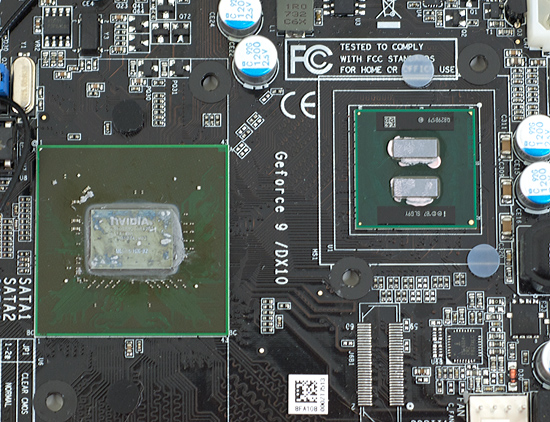
The GeForce 9300, the heart of NVIDIA's Ion platform
On the rear Zotac outfitted the world’s first mini-ITX board with every port you could possibly want. For display output you get everything that matters: VGA, DVI and HDMI. You’ve got three ways of getting audio out of the board: analog, optical or coaxial digital.

Now that's more like it
There are six, count em, six USB 2.0 ports - up from the four on the Intel boards, a single Gigabit Ethernet port (just like on the Intel D945GCLF2), eSATA and a PS2 port. I believe the only feature advantage Intel holds is that its Atom boards have two PS2 ports, one for keyboard and one for a mouse, while the Zotac board only has a keyboard port.
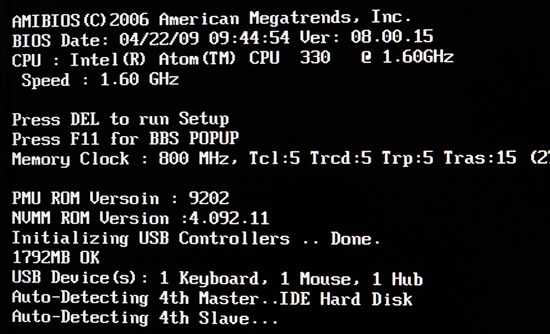
Zotac's POST screen. Spot the spelling error and embarrass Zotac for 15 points.
Assuming you have a USB mouse, Zotac wins hands down in the feature comparison and that’s without giving it extra points for having a way more capable graphics core than the D945GCLF2. I don’t think I’d change a single thing on the Zotac Ion; it’s possibly the manliest Atom motherboard on the market. *grunt*
Unique to the dual-core model I tested is an external DC power supply. The board has no ATX power supply connector on it, instead it relies on an external 90W power brick similar to what you’d get with a large notebook.
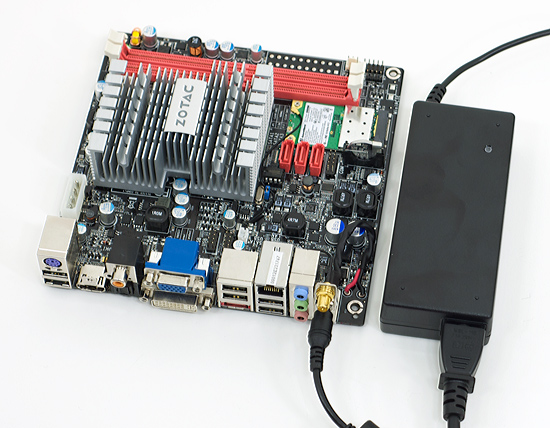
Powah
Just plug the power brick into the I/O panel of the motherboard and you’re good to go. Zotac was careful to put the DC input on the rear of the motherboard so it can still be used in any ITX case, even ones with an internal power supply.
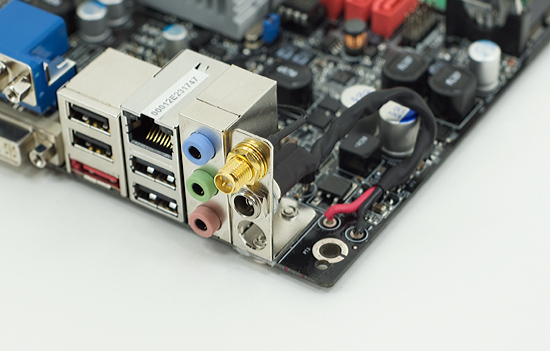
Plug the power brick into the rear panel underneath the WiFi antenna.
There’s a single 5-pin molex connector on the motherboard that can be used to power your SATA drives. Zotac ships the motherboard with a cable that provides three SATA power connectors off of the one on-board molex connector. Given that the board only has 3 SATA ports on it, the 3 power connectors should suffice. Note that they are only SATA power connectors, if you have older drives you’ll need a different cable.
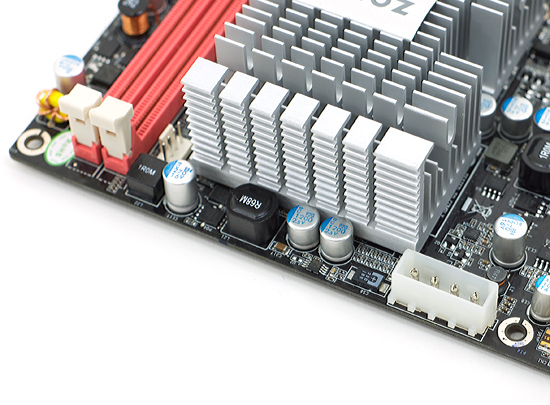
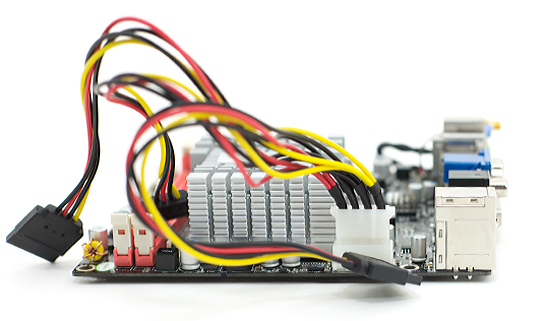
The external power supply is nice to have. It simplifies the construction of your system greatly. You can take the board and pretty much just set it anywhere you want. It’s passively cooled so you don’t need to worry about dust, just don’t put it on anything that conducts electricity.
The only issue I have with the external power supply is that it’s not as easy to replace as a standard ATX power supply. The brick is made by Delta and you might be able to find something with similar specs online, otherwise you’re left asking Zotac for another should something happen to yours.










93 Comments
View All Comments
KidneyBean - Tuesday, May 12, 2009 - link
Isn't it stealing to use Media Player Classic if you use patented decoders without paying for them?If so, I would hope you don't publish such information in articles in the future.
Penti - Friday, May 29, 2009 - link
Nope infringement is never steeling. It's pretty okay as long as it isn't used commercially. Usually your allowed to use any patents for personal use though. So it's fine. You won't go to jail. Of course he won't publish stuff that discourage the use of homebrew codecs and software that are needed for playing warez and illegally ripping your movies. It would be silly as that's what people use computers for, especially htpcs. It would really be a limited worthless device without it.sprockkets - Tuesday, May 12, 2009 - link
With MPEG4, you only pay what you publish with it, not decode.DXA for nvidia cards is clearly documented on how to use it.
Dolby Digital is another story, but seeing as how you can send the bitstream to your receiver to decode it legally, what's the big deal?
Jeffk464 - Tuesday, May 12, 2009 - link
I don't understand what the major need is to have a low power desktop. If it plugs into the wall its not really an issue like it is with notebooks. Its seems like the main focus for a Home Theater PC should be in keeping things quiet. Why not use a notebook processor and focus on making a super quiet heat sink and fan. I like the idea of compact pc's but HP has managed to squeeze a full on systems with a high end cpu onto the back of a lcd display in a nice little package.cosmotic - Tuesday, May 12, 2009 - link
How are Flash (normal animation and (HD)video) and Java graphics performance?For Java, you can install the JDK and double click the jar:
C:\Program Files\Java\jdk1.6.0_13\demo\jfc\Java2D\Java2Demo.jar
The composite and transform demos would be particularly helpful.
Anand Lal Shimpi - Tuesday, May 12, 2009 - link
I've been meaning to talk about FLV performance, I'll try and include that in a short followup soon.Take care,
Anand
strikeback03 - Tuesday, May 12, 2009 - link
The version of the Intel LF2 board you have here is already being pulled from the channel. It's replacement is the LF2D, which loses the S-Video port. Not a huge loss, as most people who tried to use it could not get what they wanted out of it (does not support different content to both the VGA and S-Video ports).Was Vista the OS for all the tests? I am using an LF2 board in my carputer with 1GB RAM, running a somewhat stripped-down version of XP on a 7200RPM 2.5" drive. Running on the car touchscreen (7", 800x480) or in PIP on my desktop monitor, and it feels pretty snappy in general usage. If I give it the full 1920x1200 though it slows down a lot, especially in my front-end software. Also, the image quality over VGA is not as good as some laptops I have hooked up to that monitor over VGA.
For carputer use I would like to see a better onboard audio codec and more ports. The 3-port thing doesn't give much flexibility on inputs and outputs.
Is the increased power consumption of the Intel boards due to using a standard ATX PSU? Did you consider getting one of the Pico-PSUs (like this: http://www.mini-box.com/picoPSU-150-XT-102-power-k...">http://www.mini-box.com/picoPSU-150-XT-102-power-k... ) to try on a more comparable basis? Also, is there any way to test the draw on each rail? The Intel boards are not really compatible with the lower-powered Pico-PSUs due to rather excessive draw on the 5V rail.
Anand Lal Shimpi - Tuesday, May 12, 2009 - link
Vista was the OS used for all of the tests and I'll second what you're saying, I've found XP far snappier than Vista with these Atom based systems. I just stuck with Vista to keep the results somewhat comparable to other CPU results.I did use a standard ATX power supply on the Intel boards but that's why I also tossed in the Eee Box results to show you what an Atom system with a smaller PSU can do.
Take care,
Anand
Jeffk464 - Tuesday, May 12, 2009 - link
I don't understand what the major need is to have a low power desktop. If it plugs into the wall its not really an issue like it is with notebooks. Its seems like the main focus for a Home Theater PC should be in keeping things quiet. Why not use a notebook processor and focus on making a super quiet heat sink and fan. I like the idea of compact pc's but HP has managed to squeeze a full on systems with a high end cpu onto the back of a lcd display in a nice little package.sprockkets - Tuesday, May 12, 2009 - link
Look at the prices on logic supply for a laptop socket itx board and how much the processor is and you will see how much cheaper this setup is.Besides, the vast majority of Anandtech readers prefer to build ourselves, not buy OEM crap.